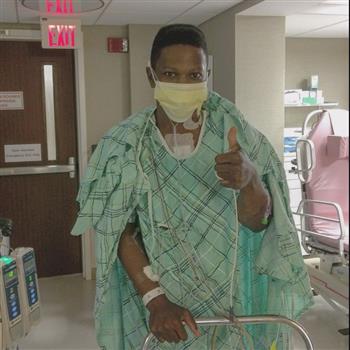Fitness Pro Shares Journey With Advanced Heart Failure
FDA expands approved use of revolutionary technology.
Andrew “AJ” Jones was doing everything right.
“I was in good shape and always in the gym,” he said. “I was making sure my diet was on point.”
At 23-years-old, AJ was a rising fitness model and coach. But there was no way he could have predicted what would happen next.
“I was out for a run, and it felt like I was breathing through a sponge,” he recalls.
That moment set into motion a two-year journey filled with sickness, fatigue, several hospital visits, and a doctor telling him, “You may not make it.”
AJ was diagnosed with cardiomyopathy — his heart was failing.
“One day you’re in the gym, and the next, you’re in the hospital. And things were going downhill pretty quick."
As time went on, he began to have a hard time walking. He couldn’t get dressed. And he dreaded going downstairs to get something to eat. At his worst, AJ found himself — once again — in the hospital where his doctors told him that he may have died if he had not sought medical care. AJ’s heart simply couldn’t keep up any longer.
“It’s the biggest wake-up call of your life,” he said. “It’s like getting hit by a truck.”
Doctors informed AJ there was only one answer — a new heart. But, he was running out of time. His health had declined so rapidly that he needed a heart pump to help keep him alive long enough while he waited for the right donor.
His best option became a left ventricular assist device (LVAD) — a device that helps those with advanced heart failure. The HVAD™ Pump (manufactured by Medtronic) is implanted next to the heart and assists the weakened left ventricle to effectively pump blood throughout the body. The HVAD pump connects to a cable, called a driveline, which exits through the abdomen and connects to the controller, a small computer that operates the pump. The HVAD™ System is powered by two batteries, or one battery and electricity.
'I want to help other people in similar positions. That’s where most of my time is being spent now.'
AJ Jones
At the age of 25, AJ was implanted with the HVAD™ System. Almost instantly, he noticed a change.
“I could feel what I’d been lacking for a year,” he said. “I felt energized. I felt stronger.”
Older-generation LVADs were larger machines and required long-term hospital stays. Today, miniaturized systems like the HVAD System are more advanced, allowing patients to leave the hospital and return to a relatively “normal” lifestyle at home.
“Patients used to need ICU support with drug therapy and other acute devices keeping them alive,” says Jim Schuermann, vice president and general manager of Medtronic Mechanical Circulatory Support (MCS). “This therapy provides a bridge on the road to a transplant. Without it, they have no other option.”
HVAD System clinical trial results show a high rate of survival, with 90 percent overall survival at six months and 84 percent survival at one year in the ADVANCE Bridge-to-Transplant (BTT) and Continued Access Protocol (CAP) trial.1
“Heart failure is a progressive disease,” Schuermann says. “Medtronic now offers an option for those in advanced stages, helping to complete a continuum of care for this patient population.”
For 13 months, AJ relied upon his HVAD System — even calling it a “life-saver.” After consulting with his physician, he returned to the gym and began to regain his strength. And then one day, an important call came in.
“My heart sank,” AJ laughs. “But when my surgeon told me we had a donor, I lost it.”
In the fall of 2016, AJ underwent a successful heart transplant. He received a new heart — and with it, a new passion.
“I want to help other people in similar positions,” he says. “That’s where most of my time is being spent now.”
Soon after the transplant, AJ resumed fitness modeling, but he also founded a nonprofit organization called Hearts at Large, a group committed to supporting others awaiting organ transplants.
“I want to advocate and support those who have gone through heart failure and those facing a heart transplant.”
Looking ahead, weights won’t be the only thing he’s lifting.
“Attitude is an important part of this, and I want to encourage people to maintain a positive outlook. This was the biggest challenge of my life, and I fought — and I believe I’m winning right now.”
References
1
Slaughter, et al. HeartWare Ventricular Assist System for Bridge to Transplant Combined Results of the Bridge to Transplant and Continued Access Protocol Trial. J Heart Lung Transplant 2013;32:675-683.
IMPORTANT SAFETY INFORMATION FOR THE HEARTWARE™ HVAD™ SYSTEM
Congestive heart failure is a condition in which a heart cannot pump enough blood to meet the body’s needs. A failing heart works, but not as efficiently as it should. As blood flow leaving the heart slows, blood flow returning to the heart will back up, causing congestion in the tissues. Along with congestion in the tissues, swelling (edema) often results. Doctors use Ventricular Assist Devices (VADs) such as the HeartWare™ HVAD™ System to treat patients who are waiting to receive a heart transplant and have severe heart failure that has not improved despite using all other treatment methods available.
The HeartWare HVAD System should not be used in patients who cannot take blood thinning medications.
Proper use and maintenance of the HVAD™ System is important to make sure the device works properly. Never disconnect from two power sources at the same time (batteries or power adapters) since this will stop the pump, which could lead to serious injury or death. At least one power source must be connected at all times. Always keep a spare controller and fully charged spare batteries available at all times in case of an emergency. Do not expose batteries to excessive shock or vibration since this may affect battery operation. Do not grasp the driveline cable as this may damage the driveline. Do not pull, kink or twist the driveline or the power cables, as these actions may damage the driveline. Special care should be taken not to twist the driveline including while sitting, getting out of bed, adjusting the controller or power sources, or when using the shower bag. Do not disconnect the driveline from the controller or the pump will stop. If this happens, reconnect the driveline to the controller as soon as possible to restart the pump.
Risks associated with the HeartWare HVAD System include, but are not limited to, surgical complications, stroke, blood clots, bleeding and infection.
This treatment is prescribed by your physician. This treatment is not for everyone. Please talk to your doctor to see if it is right for you. Your physician should discuss all the potential benefits and risks with you. For further questions, contact Medtronic.

